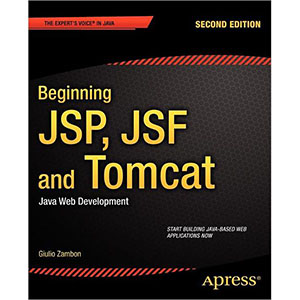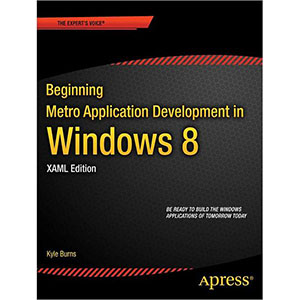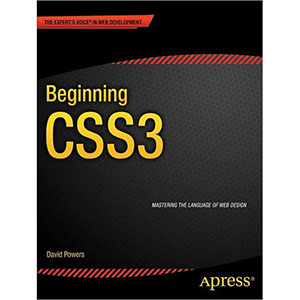| Beginning JSP, JSF and Tomcat, 2nd Edition Posted: 20 Nov 2012 03:45 AM PST 
Book Description Start building Java–based web applications now, even if you're a complete newcomer to Java. Comprehensive and example–driven, Beginning JSP, JSF, and Tomcat: Java Web Development, Second Edition is all you need to develop dynamic Java-based web applications using JSP, connect to databases with JSF, and put them into action using the world's most popular open source Java web server, Apache Tomcat. - A comprehensive introduction to JavaServer Pages (JSP), JavaServer Faces (JSF), and the Apache Tomcat web application server
- Key concepts made easy to grasp by numerous working examples and a walkthrough of the development of a complete e-commerce project
- Written for professionals by a practicing Java web application professional and expert
Table of Contents
Chapter 1. Introducing JSP and Tomcat
Chapter 2. JSP Elements
Chapter 3. JSP Application Architectures
Chapter 4. JSP in Action
Chapter 5. XML and JSP
Chapter 6. Databases
Chapter 7. JavaServer Faces 2.2
Chapter 8. JSF and eshop
Chapter 9. Tomcat
Chapter 10. eshop* Appendix A. The Web Page
Appendix B. SQL Practical Introduction
Appendix C. Abbreviations and Acronyms Book Details - Paperback: 436 pages
- Publisher: Apress; 2nd Edition (October 2012)
- Language: English
- ISBN-10: 1430246235
- ISBN-13: 978-1430246237
Note: There is a file embedded within this post, please visit this post to download the file. Related Posts The post Beginning JSP, JSF and Tomcat, 2nd Edition appeared first on Wow! eBook - Blog. 

|
| Beginning Windows 8 Application Development – XAML Edition Posted: 20 Nov 2012 03:28 AM PST 
Book Description Beginning Windows 8 Application Development – XAML Edition introduces you to the Windows 8 modern app design paradigm and the new Windows 8 programming model developed around this paradigm. You’ll learn to build rich, immersive applications designed to run on the many devices that will be powered by Windows 8. With the introduction of Windows 8, once again Microsoft has re-envisioned the way that PCs and devices will be used and applications will be built in a world that has become far more connected. The Windows 8 modern UI style is far more than a programming model and Beginning Windows 8 Application Development – XAML Edition takes you beyond the syntax of any development language. We examine the factors such as UX (User Experience), social integration, and maintaining data and settings across multiple devices. - Gives an early start to building next-generation connected applications
- Introduces new programming libraries available in Windows 8
- Explores Windows 8 app design concepts
What you'll learn
Beginning Windows 8 Application Development - XAML Edition will enable you to: - Apply Windows 8 modern UI style design guidelines to build effective user interfaces
- Consume services to bring data into your application
- Effectively use application tiles and notifications
- Use the cloud to share data and application settings across multiple devices
- Integrate with Windows by exposing your application's data to Windows Search and Share menus
Who this book is for
Beginning Windows 8 Application Development – XAML Edition is for the novice programmer with a basic understanding of .NET development who is interested in learning how to build the next generation of applications designed to run on Windows 8. Readers who already have an understanding of C# will get the most out of the book and is also an excellent choice for more experienced developers who are not sure where to start learning about programming for Windows 8. Table of Contents - Welcome to a Touch-Based World
- The Metro Design Language
- Designing Windows 8 Applications for Metro
- Metro Application Types
- XAML Controls in the Visual Studio Toolbox – The Common Controls
- XAML Controls in the Visual Studio Toolbox – Other Controls
- Building the User Interface
- Data Binding
- Introducing MVVM
- Starting the ViewModel – Data
- Inversion of Control
- The Role of Service Agents
- Asynchronous Programming Model
- Mocking the ViewModel's Behavior
- Connecting to Data in the Cloud
- Completing the Service Agents
- Interacting with Windows Search
- Notification and Tiles
- Sensors, Devices and the Location API
- Windows Marketplace and Deploying Your Metro App
Book Details - Paperback: 328 pages
- Publisher: Apress (October 2012)
- Language: English
- ISBN-10: 1430245662
- ISBN-13: 978-1430245667
Note: There is a file embedded within this post, please visit this post to download the file. Related Posts The post Beginning Windows 8 Application Development – XAML Edition appeared first on Wow! eBook - Blog. 

|
| Beginning CSS3 Posted: 20 Nov 2012 03:23 AM PST 
Book Description Beginning CSS3 teaches you how to style web pages using Cascading Style Sheets (CSS)—the language of web design. Starting from first principles, you'll learn through a series of practical exercises how to change the default look of HTML tags, adding color, backgrounds, and borders. The book demystifies core concepts, such as the CSS box model and selectors, giving you the confidence and knowledge to create innovative and flexible page layouts. You'll also learn how to create rounded corners, drop shadows, and gradients without the need for images, using the latest CSS3 techniques. What you'll learn - Teaches how to style attractive and flexible web pages
- Hands-on exercises demonstrate how to combine style rules for different effects
- Comprehensive coverage of CSS2.1 and stable parts of CSS3
Who this book is for
Beginning CSS3 is aimed at web designers who want to master the use of Cascading Style Sheets to style and lay out modern web pages. It teaches core concepts, such as the CSS box model and choosing the most appropriate selectors to apply styles efficiently. This makes it an excellent choice for both complete beginners and web designers who want to improve their understanding of CSS. Table of Contents - Introducing CSS – the Language of Web Design
- Using Basic Selectors
- Specifying Sizes, Colors, and Files
- Styling Text
- Embedding Web Fonts
- Understanding Layout with the CSS Box Model
- Floating Elements for Layout
- Adding Backgrounds
- Adding Borders and Drop Shadows
- Styling Lists and Navigation Menus
- Positioning Elements Precisely
- Cross-Browser Layout Techniques
- Using Advanced Selectors
- Styling Tables
- Generated Content
- Creating a Print Style Sheet
- Targeting Styles at Different Devices with Media Queries
- Using CSS3 Multi-Column Layout
- Creating Gradients Without images
- 2D Transformations and Transitions
- Animating Elements with CSS Keyframes
- What Next?
Book Details - Paperback: 568 pages
- Publisher: Apress (October 2012)
- Language: English
- ISBN-10: 1430244739
- ISBN-13: 978-1430244738
Note: There is a file embedded within this post, please visit this post to download the file. Related Posts The post Beginning CSS3 appeared first on Wow! eBook - Blog. 

|
| Beginning iOS Storyboarding: Using Xcode Posted: 20 Nov 2012 03:19 AM PST 
Book Description For the beginner who has never programmed, Beginning iOS Storyboarding shows how to extract those cool and innovative app ideas you have in your head into a working app ready for sale on the iTunes store by using Apple’s new Storyboarding technology. Storyboarding allows you to skip chunks of code by just dragging scenes and segues onto your Storyboard canvas. A time saver for sure, but it’s new! Dr. Rory Lewis, Yulia McCarthy and Stephen Moraco — a best selling Apress author, a former Apple iOS engineering group intern and a successful app developer — have teamed up to bring you this book, Beginning iOS Storyboarding. The three authors have found a beautiful way to lead the beginner into Storyboarding and at the same time show old school coders of Objective-C the new and exquisite methodology of this incredible tool. Even if you’re an intermediate or pro-level Objective-C developer, you can still learn the ins and outs of Xcode’s new Storyboarding feature, and find new ways of building and debugging your new Storyboarding app. Yup: This book is also for you, too. In this book, you get the following, beyond learning the fundamentals and classical elements of Storyboarding: - Design and build utilities and a location based service app using Storyboarding techniques
- Design and build a universal app with a rich user interface and user experience (UX)
- Create a fun game app, and more
What you'll learn - How iOS Storyboarding is like a different planet in the Xcode universe. We do this by introducing you to the standard transitions to views, passing data to the views, returning data from the views, and, lastly, showing how to navigate the critical transitions to views.
- How to develop a simple utility app using Storyboarding. Here we learn the foundation of many apps, which is how to place controls on the settings screen of a utility application and to return those settings to the main view of the app via the settings view delegate protocol.
- How to develop an app with an advanced MKMapView. Specifically, we introduce you to override the default views provided by Apple's initial project templates. This opens the door to you being able to code specialized views such as MKMapView, and utilize iOS Location Services for building navigation-based apps.
- What are the cool, powerful tools that enable you to create page controller view transitions. We dig deep into the ins and outs of how to apply the UIPageControls to display views and supply traditional view notification to controlled views.
- How to create a very cool universal app while you learn how to develop table views, which in the iPad case, present themselves differently depending upon the device orientation using the UISplitViewController.
- How to build a universal app with two Storyboards (one for iPhone, one for iPad) and provide techniques and tips for developing universal apps.
- How to develop a cool game app which stretches your knowledge of how segues can be used to provide much more complex navigation paths between screens and devices.
Who this book is for
This book is for the beginner who has never programmed, but can use the Storyboarding tool in Xcode to get up and running fast. This book is also for experienced iOS developers who wish to learn Storyboarding to quickly cut down on their app development and debugging time. Table of Contents - Preliminaries
- Fundamentals
- Storyboarding with MapView
- Building a Utility Application
- Storyboarding a Page-Based App
- Mastering Table Views with Storyboarding: Core Data Setup
- Mastering Table Views with Storyboarding: Designing the Flow
- Mastering Table Views with Storyboarding: Coding the Backend
- Single View #3: wanderBoard Part I
- Single View #3: wanderBoard Part II
- Single View #3: wanderBoard Part III
- How Far You Have Come
Book Details - Paperback: 644 pages
- Publisher: Apress (October 2012)
- Language: English
- ISBN-10: 1430242728
- ISBN-13: 978-1430242727
Note: There is a file embedded within this post, please visit this post to download the file. Related Posts The post Beginning iOS Storyboarding: Using Xcode appeared first on Wow! eBook - Blog. 

|
| .NET Test Automation Recipes Posted: 20 Nov 2012 03:15 AM PST 
Book Description If you develop, test, or manage .NET software, you will find .NET Test Automation Recipes: A Problem-Solution Approach very useful. The book presents practical techniques for writing lightweight software test automation in a .NET environment and covers API testing thoroughly. It also discusses lightweight, custom Windows application user interface automation and teaches you low-level web application user interface automation. Additional material covers SQL stored procedure testing techniques. The examples in this book have been successfully used in seminars and teaching environments where they have proven highly effective for students who are learning intermediate-level .NET programming. You'll come away from the book knowing how to write production-quality combination and permutation methods. Table of Contents
Chapter 1. API Testing
Chapter 2. Reflection-Based UI Testing
Chapter 3. Windows-Based UI Testing
Chapter 4. Test Harness Design Patterns
Chapter 5. Request-Response Testing
Chapter 6. Script-Based Web UI Testing
Chapter 7. Low-Level Web UI Testing
Chapter 8. Web Services Testing
Chapter 9. SQL Stored Procedure Testing
Chapter 10. Combinations and Permutations
Chapter 11. ADO.NET Testing
Chapter 12. XML Testing Book Details - Paperback: 404 pages
- Publisher: Apress (October 2012)
- Language: English
- ISBN-10: 1430250771
- ISBN-13: 978-1430250777
Note: There is a file embedded within this post, please visit this post to download the file. Related Posts The post .NET Test Automation Recipes appeared first on Wow! eBook - Blog. 

|







Tidak ada komentar:
Posting Komentar